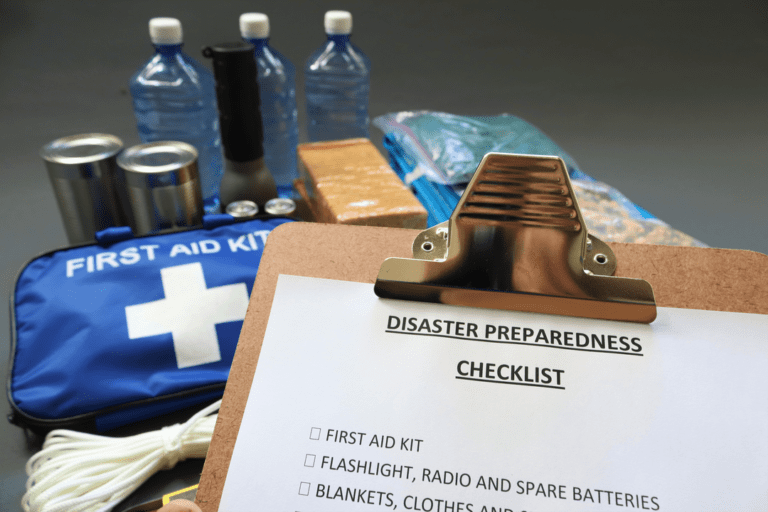BIG Special Discounts Available NOW! Check out our Products
Leader in Waste Management Solutions | PROUDLY MADE IN THE USA ![]()
Leader in Waste Management Solutions | PROUDLY MADE IN THE USA ![]()

Without a doubt, there’s an increase in frequency and damage caused by major storms and tornadoes nationwide, such as the tornados that tore through Kentucky and the Midwest in December 2021 as well as the “superstorm” hurricanes.
Overall, 2021 was hailed as the second costliest year on record for the insurance industry ($145 billion) thanks to losses caused by natural disasters and secondary perils—i.e. smaller storms that bring hail, high winds, tornados, and flooding.
Read between the lines, and you’ll see where we’re headed: the need for emergency response and disaster supply kits and gear is rising.
Whether rescuing trapped victims, controlling the crowds, or treating and transporting victims, being a first responder in the wake of a natural disaster could mean long hours on call. At some point, first responders – or those they’re helping – will need to relieve themselves.
And while including waste bags in disaster prep gear makes the most sense, it’s not an industry standard. (We’d like to make it one.)
Here are five reasons why disaster preparedness should involve putting waste bags in supply kits and gear.
In times of calamity, food, water, first aid, and shelter are the main concerns. But these aren’t the only basic human needs. A basic human need is also being able to relieve oneself in a timely, sanitary manner.
At some point, nature calls, and every person needs to answer her.
But can’t people just hold it in for a few hours? You might ask. They could, but that can lead to even more painful complications.
Holding the urge to pee for extended periods of time can increase the risk of bladder infections and weaken bladder muscles. And holding in poop can cause severe constipation and bloating (… if there weren’t enough problems already!).
Response teams typically hand out blankets and basic disaster supply kits to civilians. They’re also likely to carry the same essentials for themselves, just in case.
These kits include what’s necessary to cover one’s basic needs—water, non-perishable food, and a first aid kit. But as we mentioned, going to the bathroom should also be considered a basic need.
By stashing a waste bag in a disaster supply kit or go bag, not only will civilians have their bathroom needs taken care of, but first responders will as well.
Natural disasters can leave roads inaccessible due to debris and fallen trees. Water utilities can be shut down to avoid contamination of water sources. And even if the disaster doesn’t destroy power lines, electricity will likely be turned off to prevent the risk of igniting leaking gas or causing an explosion.
If you put the dots together, you’ll see this is the perfect recipe for a clean freak’s worst nightmare.
No electricity means non-flushing toilets and having to find bathrooms in the dark at night. No running water means no ability to wash hands before or after using the bathroom. And the cherry on top—there could be a considerable number of people using the same bathroom.
In the same light (no pun intended), spending too much time searching for a bathroom can impact the speed at which first responders conduct search and rescue operations or deliver medical attention. And assisting those who need to go also takes time away from the life-saving tasks at hand.
By including waste bags in disaster supply kits and first responder gear, everyone impacted will have an optimal solution for their bathroom needs.
Considering the drastic turn of events and benefits to having a waste bag handy when disaster strikes, including them in supply kits, gear, and “go bags” just makes sense.
Having said that, not all waste bags are created equal. First responders need one that’s durable enough to withstand rough handling, convenient enough to be used anywhere, and sanitary enough to help people feel clean despite the unfortunate circumstances.
We’d be doing you a disservice if we didn’t introduce Brief Relief, a solution that offers first responders and the civilians they assist with a sanitary, convenient, and portable bathroom solution.
Brief Relief Liquid Waste Bags are puncture-resistant, odor-free, and spill-proof triple barrier bags for human waste. They use a specialized technology that converts waste into a deodorized gel, and they come complete with toilet paper and antimicrobial wipes.
When finished, Brief Relief waste bags can be thrown away in any regular trash bin as they’re made with non-toxic materials and are landfill-safe.
And if there’s nowhere private to go, Brief Relief’s Liquid Waste Bags can be easily paired with commode systems and portable shelters. (These include travel systems, curtains, canopies, and tents.)
For first responders in the aftermath of a natural disaster, where to go to the restroom should be the LAST worry on their minds—or the minds of those they’re helping—at the end of the day.
With waste bags, they can stay focused and save time, which could ultimately mean the difference between life or death.